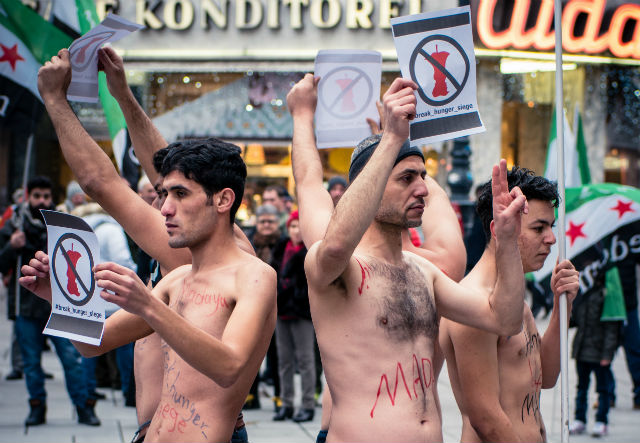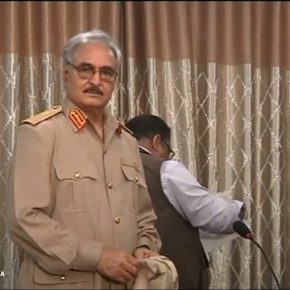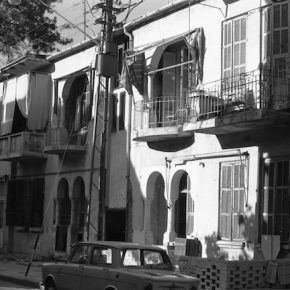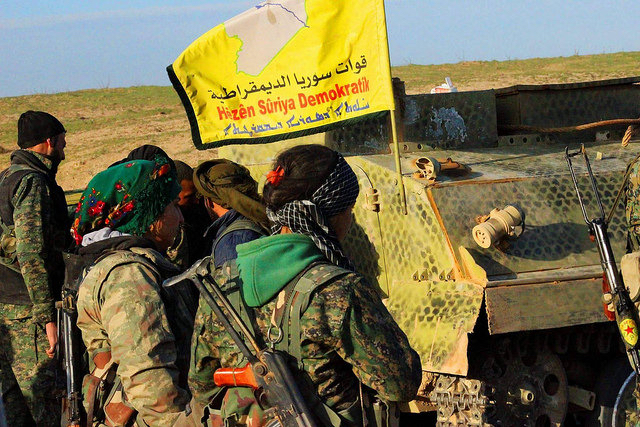Cases of meningitis and malnutrition-related growth deficiencies are increasing in the besieged town of Madaya, where humanitarian aid deliveries are sporadic and insufficient.
IN LATE SEPTEMBER, aid convoys made their way to the besieged mountain town of Madaya, only an hour’s drive from Damascus, for the first time in six months. But the delivery lacked much-needed medicine and supplies to treat the infectious diseases and malnutrition rapidly spreading in the town.
The siege of Madaya received international attention in January when photos of skeleton-thin children circulated on social media, sparking concern for the nearly 40,000 residents trapped inside, slowly dying from hunger and untreated infectious diseases. Ten months later, bureaucratic, political and military complications mean aid deliveries are insufficient and sporadic and the lack of supplies continues to devastate locals’ health and livelihood.
At least 86 people have died from siege-related causes in Madaya, 65 of them from starvation, according to a report published by the global nonprofit Physicians for Human Rights (PHR) and the Syrian American Medical Society (SAMS) in July.
Encircled by government forces and the Lebanese Hezbollah militia, Madaya’s fate is tied to three other besieged towns: rebel-held Zabadani and government-controlled Kefraya and Foua, besieged by rebels in Idlib province. Under the Four Towns Agreement, a September 2015 deal which sought to end hostilities, facilitate aid deliveries and evacuate urgent medical cases, aid deliveries must be made simultaneously to all four towns.
Madaya has received the most aid of the four towns, but its larger population (including many who were forcibly displaced from neighboring villages) and its poor medical infrastructure have made it ripe for health catastrophes. With no lab equipment, X-ray machines, MRIs, CT scanners or even the necessary antibiotics, Madaya’s medical staff are often left wringing their hands in the hope that aid, or at least medical evacuations, will come in time to save their patients.
“I cannot tell what is happening with a patient except based on what they’re telling me, because we don’t have diagnostic machines or specialized staff,” said Muhammad Darwish, one of three field doctors operating in Madaya. Darwish was a fourth-year dental student when he began working at the field hospital in Madaya. Working with him are another dentistry student and a veterinarian, with little equipment and only field expertise.
Aid convoys, besides being irregular, are also often insufficient and lack medicine. Previous aid shipments had been stripped of essential supplies, according to the report by SAMS and PHR, including inpatient stabilization kits for children with severe malnutrition, surgical items and medication for diabetes, heart disease, kidney and liver diseases.
Dr. Annie Sparrow, an associate professor and deputy director of the human rights program at the Icahn School of Medicine at Mount Sinai, who currently focuses on the Syrian conflict, told Syria Deeply that the most recent delivery to Madaya did not contain any antibiotic treatment for meningitis.
“Not only did they not send any of these drugs … they didn’t send any drugs to prevent close contacts and family members from getting it or to prevent it spreading,” Sparrow said.
At least 27 cases of meningitis were recently diagnosed in Madaya, Darwish said. A highly infectious disease, meningitis is “an inflammation of the protective membranes covering the brain and spinal cord,” according to the Centers for Disease Control and Prevention. Left untreated, the disease can be life-threatening.
“Meningitis is usually caused by either bacterial or viral infection,” said Darwish. “Since we do not have adequate medical equipment, we are not able to make the right prognosis [and] we lack medication to treat meningitis.”
Even if proper treatment is available, poor sanitation and weak immune systems make it difficult to fight off infectious diseases. In the six-month aid hiatus, malnutrition was on the rise again in Madaya, affecting children most severely.
The absence of meat, vegetables, fruit and milk have caused serious mineral and vitamin deficiencies, including stunted growth and bone deformations. “Stunting is a manifestation of chronic malnutrition over a period of several years,” a UNICEF official told Syria Deeply. “The longer the current conflict in Syria continues, the higher the possibility of having irreversible health conditions among children.”
According to the town’s medical staff, at least 500 children are calcium deficient, and at risk of various complications. Some 75 children under the age of 3 are not able to walk, and many are unable to develop teeth. One case of rickets, where a child’s severe vitamin deficiency leads to bowed legs and other bone distortions, has been diagnosed.
The most recent shipment did not include medication for chronic illnesses like diabetes, high blood pressure or kidney diseases, Darwish said, adding that the basic food supplies did not include the necessary amount of milk for children suffering calcium deficiencies.
The World Food Program (WFP) facilitates aid deliveries to Madaya, and despite the delays “there’s a constant effort to secure the clearances and all parties of the conflict to reach every area, in the country,” said Dina El-Kassabi, regional communications officer at WFP.
However, the aid delays dictated by the details of the Four Towns Agreement leave the residents of Madaya in a situation where they have little control.
“Deliveries were approved for May, June, July and August, but none of them went through. We heard the delays were due to fighting on the ground and because [rebel group] Ahrar al-Sham was not allowing aid into Foua and Kafraya,” said Elise Baker, a research coordinator at PHR. “If this is true, it further illustrates the absurdity of the Four Towns Agreement. Humanitarian agreements should not be political. They should be based on humanitarian principles and allow aid to go to those most in need.”
Madaya is surrounded by nearly 6,000 land mines and 65 sniper-manned checkpoints to ensure residents cannot flee, but many have tried as the siege continues to suffocate the town. A land mine victim was recently evacuated, Darwish told Syria Deeply, but his evacuation was stalled for days because of clashes near Foua and Kefraya.
“There had been hope to save his leg – he was still able to move and feel it – but as soon as he was evacuated, his leg was immediately amputated because it started to get gangrenous,” Darwish said. “These are the kinds of problems that we experience with the constant delays.”
This article originally appeared on Syria Deeply, and you can find the original here. For important news about the war in Syria, you can sign up to the Syria Deeply email list. Photograph courtesy of Alen Djuderija. Published under a Creative Commons license.





